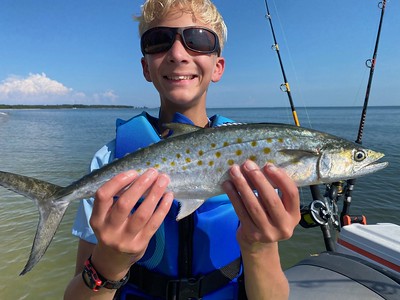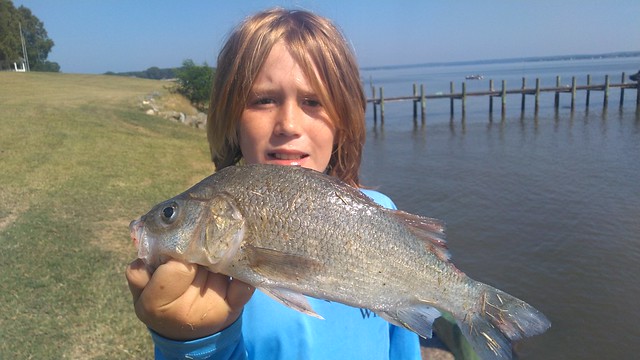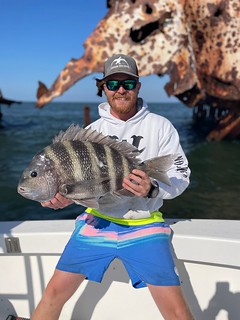Maryland Fishing Report – August 30

Logan Zupancic got to go fishing with his dad recently and is very happy to hold up his first Spanish mackerel for the camera. Photo by Marty Zupancic
As we go into the Labor Day weekend, there is still plenty of summer fishing action to be shared with family and friends.
Remember that while you are fishing, you can also be a citizen scientist! Take a few minutes to help Department of Natural Resources biologists monitor our various fish populations by filling out a volunteer angler survey on the species you’re catching. On the department website, just search for volunteer angler surveys to find your fish and enter the requested data. For ease of use, you can also access the surveys through the free AccessDNR app.
Forecast Summary: August 30 – September 5:
The upcoming week will feature hot and sunny days and cooler nights, with no rain in the forecast. These conditions should result in a slight rise of Chesapeake Bay water temperatures to above 81 degrees. Bay salinity is still above average. Oxygen conditions are slightly better below Bloody Point to the state line, with most places recording suitable fishing depths down to at least 35 feet. In the area from Tolchester to the Bay Bridge, avoid fishing below about 20 feet. Check the areas of low oxygen map to help determine the maximum fishing depth in your favorite area.
The Maryland Department of Natural Resources has developed an online striped bass habitat conditions mapping tool on our website, applying newly developed water temperature and dissolved oxygen-based thresholds for Maryland’s resident striped bass. This tool will help you identify current conditions at your local fishing hotspots so you can fish at the most suitable locations.
Expect average flows in Maryland rivers and streams all week. There will be above average tidal currents all week as a result of the August 30-31 full moon. Expect average clarity in Maryland’s waters. To see the latest water clarity conditions, check Eyes on the Bay Satellite Maps.
As always, the best fishing areas could be further refined by intersecting them with underwater points, hard bottom, drop-offs, and large schools of baitfish.
For more detailed and up-to-date fishing conditions in your area of the Bay, be sure to check out Eyes on the Bay’s Click Before You Cast.
Although the Conowingo Dam remains on an afternoon and evening power generation schedule, the releases have fluctuated in volume this week. Anglers are casting a mix of topwater lures and paddletails into the turbine wash at dawn and late evening and catching striped bass, and at times flathead and blue catfish are chasing down lures. Drifting fresh cut bait in the dam pool is a surefire way to hook up with the catfish that reside there.
The lower Susquehanna River continues to provide excellent fishing for blue catfish. There are many locations to fish from along the shores of Havre de Grace and Port Deposit, and all you need is a sturdy fishing outfit and fresh cut bait. Anglers on the river at dawn and late evening are working the edges of the Susquehanna Flats with topwater lures and paddletails for striped bass.
The striped bass fishing fleet continues to focus on using spot and eels for live-lining near the mouth of the Patapsco River. Anglers are also venturing into Baltimore Harbor and finding good fishing there along channel edges and the piers of the Key Bridge. Most are succeeding with live-lining, but others are having good luck jigging with soft plastics. Anglers are also enjoying good striped bass action along the piers, wharfs, and old piling fields by casting topwater lures and paddletails during the early morning and late evening.
Anglers are urged to record the measurements of striped bass they release and keep on the Maryland striped bass angler’s survey. The survey is found on the Department of Natural Resources website by searching Volunteer Angler Surveys.
Anglers are finding striped bass near Pooles Island, the Love Point rocks, and any location along channel edges where striped bass can be found suspended. Most anglers are using eels and spot for live-lining at Pooles Island and at Love Point rocks, and jigging is also popular. Trolling deep umbrella rigs and tandem rigged paddletails and bucktails dressed with curly tails is another option along channel edges.
Spot can be found in several locations inside the lower Patapsco River, the Magothy River, and other areas within the upper Bay – these are good for live-lining and many are now large enough to eat. White perch will be mixed in these same locations and pieces of bloodworm or artificially scented baits are popular. Some of the knolls in the upper Bay, along with tidal rivers and creeks, also hold white perch.
Anglers traveling in boats near the Bay Bridge are advised that a 6-knot speed limit zone has been instituted for boats of all sizes, as crews make repairs to the eastbound span. The speed limit is in force until March 31, 2026, to reduce boat wake interference with barges carrying crews and equipment.
Anglers are finding some striped bass action along the eastern side of the Bay Bridge at the pier bases near the 25-foot drop-off. Most are using spot or eels for live-lining, but some are having good luck with cut spot. The early morning hours during a good running tide offer the best fishing. Casting soft plastic jigs near the pier bases is a good option during the early morning.
Anglers are finding striped bass along shoreline structure during the early morning at locations throughout the middle Bay. The shallower waters in the lower sections of the Choptank River, Eastern Bay, the rocks at Poplar Island, the Naval Academy, and Thomas Point are just a few of the locations holding striped bass. Most anglers are casting poppers, jerkbaits, spinnerbaits, or paddletails. Speckled trout and puppy drum can be part of the mix.
A mix of Spanish mackerel and bluefish are being found throughout the middle Bay along channel edges. The shipping channel edges from Buoy 83 south past the Sharps Island Light and the False Channel area are excellent places to look for them this week. Trolling small Drone Spoons or gold Clark Spoons behind No. 1 planers at 7-8 knots is a popular way to catch them.
Anglers can sometimes spot breaking fish by watching for diving gull activity, and then enjoy some fun casting action if they approach carefully. Small heavy and flashy metal jigs or Got-Cha lures cast into the fray and retrieved quickly can catch Spanish mackerel, while a slower retrieve will catch bluefish and cutlass fish. Anglers should watch for slicks that can indicate feeding activity nearby. Bay anchovies are the primary prey species.
White perch offer plenty of fun fishing for those casting small spinnerbaits, roadrunners, and beetle-spin lures along shorelines of the tidal rivers and creeks. The early morning and late evening offer the best opportunities near shoreline structure. Submerged rocks, bulkheads, jetties, and breakwaters are just a few structures that can hold white perch. Casting small minnows under a bobber near shoreline structure can also work well on larger white perch. Fishing in deeper waters off docks and piers is often done with a simple bottom rig baited with grass shrimp or pieces of bloodworms or peeler crab.
Anglers fishing for striped bass in the lower Bay are working the shallower areas of the region’s tidal rivers, creeks, sounds, and bay shorelines. The best opportunities tend to be during the early morning and late evening. Casting a mix of paddletails, spinnerbaits, jerkbaits – and in some areas, poppers – has been working well. Anglers are catching a mix of striped bass, speckled trout, puppy drum, and cutlass fish.
Spanish mackerel and bluefish are a big focus for anglers this week. The waters at the mouth of the Potomac River, Cedar Point to Point Lookout, the area from Buoy 72A past the Target Ship, and Tangier Sound are all popular places to find Spanish mackerel and bluefish. Most anglers are trolling small Drone and Clark spoons behind No. 1 planers at about 8 knots.
Fishing for spot at the mouth of the Patuxent River could hardly be better. Anglers are filling ice chests with large spot. They are also catching a mix of kingfish, white perch, small croakers, and sea bass. Good fishing for spot can also be found in Tangier Sound.
Anglers are finding some large sheepshead along with a few cobia near the Target Ship. This past week has seen better opportunities for cobia by chumming and fishing with live eels as well as trolling surgical tube lures near the Target Ship and Smith Point areas. Large red drum continue to be found near Point Lookout and near the Target Ship and Middle Grounds. They can be caught by trolling large spoons or jigging with large soft plastics where a school can be located.
Good recreational crabbing is reported in all regions of the Bay this week. The size of the crabs can be very impressive, at times measuring 7 inches or better. The largest crabs tend to be found in waters 10 feet or more deep. Collapsible crab traps and net rings are working well when the crabs start to drop off trotlines as the sun climbs into the sky.
In the trout waters of western and central Maryland, low flows are creating a situation where stealth and long casts with light tippets are necessary to fool resident trout holding in deeper pools and lays. On the upper Potomac River, water levels are low enough that anglers, if careful, can wade out to reach areas inaccessible by boat. Long casts with light lines during the early morning or late evening offer the best opportunities for smallmouth bass when casting a mix of tubes, small crankbaits, and poppers.
Recent seining surveys for young of the year smallmouth bass showed 4.1 fish per seine haul on the Monocacy River and 2.5 fish per seine haul on the Conococheague Creek. The long-term median score for young of the year smallmouth bass is 1.5 fish per seine haul, so this is good news for smallmouth bass recruitment.
Northern snakeheads are beginning to leave their fry balls this week and they are thinking more about feeding as water temperatures begin to cool slightly. The thick grass beds in the shallows of the tidal rivers and creeks of the Chesapeake Bay are holding snakeheads that will charge buzzbaits, chatterbaits, and soft plastic frogs.
Largemouth bass are still holding to a summer pattern and will do so until water temperatures cool down in late September. A good tactic is fishing in the late evening or early morning using topwater lures and various soft plastics in the shallower waters where grass beds exist. As the day wears on, dropping wacky rigged plastic worms down through floating grass mats is a good way to entice lounging fish to pick up a bait. Largemouth bass will seek cool shade wherever they can find it – docks, fallen treetops, floating grass, deep water near sunken wood, or the shade of bridge piers and overhanging brush, all provide some relief from the hot sun.
Surf anglers continue to enjoy a summer mix of kingfish, spot, bluefish, and flounder this week. Bloodworms and artificial bloodworm baits are catching the kingfish and spot. Cut spot or finger mullet is being used for bluefish and cut spot or squid for flounder. A few large red drum are being caught and released during the evening, along with inshore sharks, usually on large cut bait.
At the Ocean City Inlet, sheepshead are being caught near the jetty rocks and bridge piers on sand fleas, while flounder are taking Gulp baits worked along the bottom. Drifting with live spot or finger mullet is working well for the larger flounder. Anglers casting soft plastic jigs or Got-Cha plugs are catching a mix of bluefish and striped bass.
Flounder can be found in the channels near the inlet and back bay waters. Drifting with live spot or other small fish, or with pink or white Gulp baits, is a good tactic for targeting the larger flounder. Squid strips and minnows work well for flounder, but juvenile sea bass can be pesky when fishing with squid.
Outside the inlet those trolling with small Clark and Drone spoons behind No. 1 and No. 2 planers are catching bluefish and Spanish mackerel on some of the inshore shoals. The boats headed out to the offshore wreck and reef sites are finding a mix of sea bass, flounder, and small dolphin for their anglers.
At the offshore canyons, anglers are catching and releasing both white and blue marlin and there was a report of one sailfish release recently. A mix of bigeye and yellowfin tuna are being caught and small dolphin are being found near floating debris and lobster buoys. Deep drop anglers are catching a mix of blueline and golden tilefish.
“A day fishing is never a waste. The old-timers know that cooperation by the fish is the icing, but there’s plenty that can stick with the cake, trying out a new rod or reel or waders, or watching, always with a feeling of seeing a miracle, feeding fish making little diamonds on the surface of the stream.” – Gene Hill
Maryland Fishing Report is written and compiled by Keith Lockwood, fisheries biologist with the Maryland Department of Natural Resources.
Click Before You Cast is written by Tidewater Ecosystem Assessment Director Tom Parham.
This report is now available on your Amazon Echo device — just ask Alexa to “open Maryland Fishing Report.”






 1-888-373-7888
1-888-373-7888 233733
233733